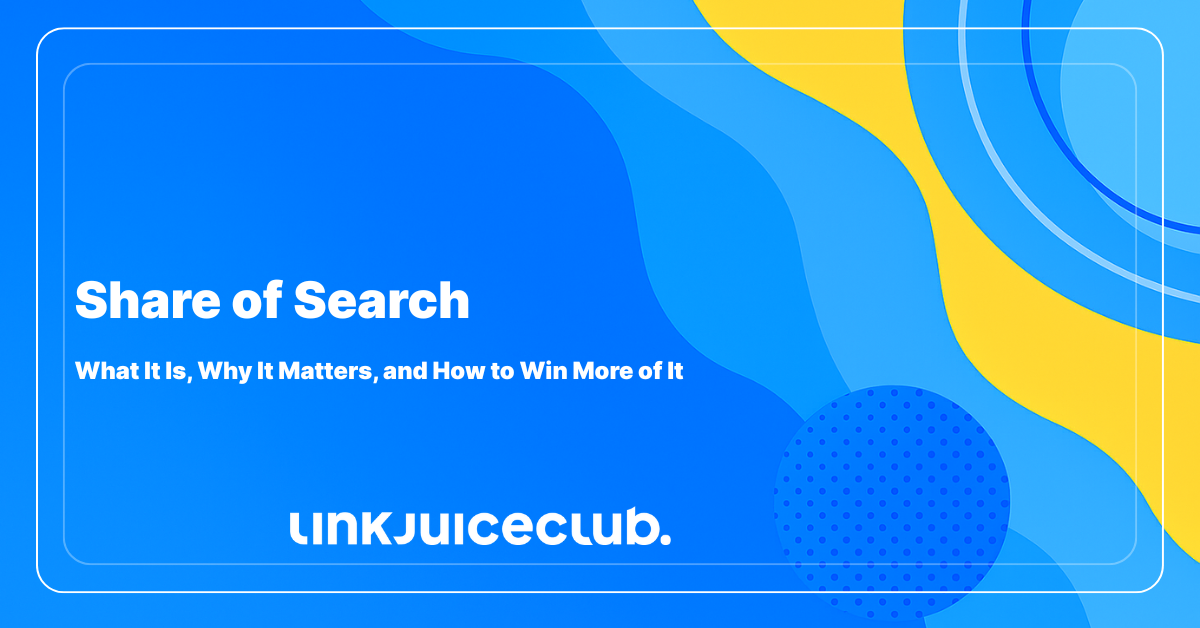
Share of Search: What It Is, Why It Matters, and How to Win More of It
Branded search isn’t just a vanity stat. It’s one of the most honest, unfiltered signals your audience gives you.
You can buy impressions, force clicks, or flood feeds. But you can’t fake someone typing your name into Google with intent.
That’s the power of Share of Search — a live, data-driven look at who’s commanding attention. And in 2025, it’s becoming one of the most useful KPIs in your brand toolkit.
In this guide, we’ll break down exactly what SoS is, how it compares to other metrics, how to measure it properly, and — most importantly — how to grow it with strategies that actually work.
Let’s get into it. 📈
What Is Share of Search?
At its core, Share of Search (SoS) shows what percentage of branded searches in your industry are about you — and no one else. It’s a dead-simple way to understand how much demand your brand is generating relative to your competition.

Here’s the formula that makes it tick:
Share of Search =
(Searches for your brand ÷ Total branded searches in your category) × 100
Let’s say your brand is searched 40,000 times in a month, while competitors combine for 160,000. That gives you a neat 20% SoS..
And yes, it’s that straightforward. There’s no black-box attribution model or attribution delay — it’s real numbers reflecting real people making a conscious decision to search your brand by name.
It’s not about impressions. It’s about intent. Branded searches are active signals — someone typing your name means they’ve heard of you, remembered you, and are curious enough to take the next step. They’ve skipped the middleman and gone straight to your front door.
What makes SoS even more powerful is how clean the signal is. You can’t buy it. You can’t inflate it. You can’t fake it. Unlike impressions or click-throughs, there’s no room for bots or accidental views — just direct human behavior, captured in one of the most trusted data sources out there.
And in a digital world where most metrics feel increasingly muddy, SoS stands out as sharp, simple, and surprisingly underrated.
Share of Search vs Share of Voice vs Share of Market
These three metrics often get lumped together — and honestly, the names don’t help. But once you understand how they stack, they become one of the clearest frameworks for understanding brand performance over time.
Let’s break them down:
- Share of Voice (SOV): This tells you how loud your brand is in the market. It covers things like ad impressions, PR mentions, media coverage, and social chatter. It doesn’t matter if people are engaging — it just measures if you’re showing up.
- Share of Search (SoS): This is about interest. It captures how often your brand is being looked up compared to your direct competitors. It’s not just a measure of visibility, but of resonance — are people curious enough to go deeper?
- Share of Market (SOM): This is where rubber meets road. It tracks your actual revenue or sales share in your industry. It’s the result of everything that came before — if SOV is your fuel and SoS is your ignition, SOM is your engine output.
Here’s how they connect in a simple funnel:
Voice builds awareness →
Search signals intent →
Market reflects outcomes
If your Share of Voice is high but SoS isn’t budging, it’s a sign your messaging may not be cutting through. You’re shouting — but no one’s leaning in. If your SoS is climbing but your SOM stays flat, something is breaking in the customer journey — perhaps your site, offer, or onboarding.
But when all three are aligned — high voice, high search, and growing market share — you know your brand is hitting hard at every stage of the funnel.
Tracking all three gives you a clear, honest view of your brand’s momentum. It’s not just about clicks or conversions anymore — it’s about attention, memory, and impact.
Why Share of Search Hits Harder in 2025
📉 Zero-Click Is the Norm Now
Search isn’t just about driving clicks anymore — it’s about showing up at all. With AI Overviews, featured snippets, and instant answers crowding the top of Google’s SERP, users are increasingly getting what they need without visiting a site. That means traditional click-through rates are shrinking, especially for non-branded, high-funnel queries.
But branded searches? Those cut through the noise. When someone types your brand name directly, they’re not looking for a generic answer — they’re looking for you. Whether they click or not, that query is recorded, tracked, and interpreted by search engines and AI models alike. You’re signaling relevance in a way no ad campaign can fake.
The intent behind branded queries is stronger, and the competition is lower. In an ecosystem where organic visibility is no longer guaranteed, brand demand is the algorithmic shortcut.
🤖 AI Is Watching the Signals
Search engines are no longer the only gatekeepers of brand visibility. AI assistants and large language models like ChatGPT, Claude, and Perplexity are now shaping what people see — and they’re heavily influenced by brand popularity and recognition.
When these tools generate responses, they don’t just pull from site rankings — they infer credibility from signals like mentions, links, and search frequency. If your brand has a high share of search, you’re more likely to be mentioned, recommended, or even set as a default in AI-generated content.
This flips the traditional SEO model on its head. It’s no longer about who ranks highest in blue links — it’s about who gets surfaced without even being asked. The higher your branded demand, the more often AI will “choose” you over your competitors.
And as users grow more reliant on AI tools for decision-making, these algorithmic picks could become more influential than organic SERPs themselves.
⏳ Share of Search Moves Faster Than Sales
Sales is a lagging indicator. Even website traffic takes time to build and analyze. But search behavior shifts right now — and SoS captures those shifts in near real-time.
If you just launched a campaign, ran a webinar, dropped a new feature, or landed some press coverage, SoS is one of the first places you’ll see the results. A branded search spike within 24–72 hours is often the best signal that people noticed — even before conversions or social engagement kick in.
And the reverse is true too. If your Share of Search flatlines post-launch, it means your message didn’t stick, your offer wasn’t memorable, or your audience didn’t care enough to follow up.
That feedback loop is gold. It lets you course-correct faster, test messaging more intelligently, and allocate budget toward strategies that actually generate intent.
How to Measure Share of Search (The Smart Way)
You don’t need enterprise software or custom APIs. But you do need to look in the right places — and compare yourself only to relevant players.

Here are three battle-tested methods.
🔍 Google Trends (Fast, Free, and Surprisingly Powerful)
How to do it:
- Go to Google Trends
- Type in your brand name
- Click “+ Compare” and add competitors
- Filter by location and set the time window to 12 months
You’ll get a clean graph showing relative search interest over time.
Each brand gets a score from 0 to 100 — but remember, this isn’t total search volume. It’s a normalized index based on each brand’s peak.
💡 Use Trends to track campaign spikes, seasonal interest, or unexpected drops. You can even compare how new competitors are trending against legacy brands.
How to Grow Your Share of Search
Time to shift from tracking to action. Here’s how real brands grow their SoS and stay top of mind.
1. Hijack Mentions That Don’t Include You (Yet)
Your competitors are showing up in comparison posts, product roundups, and industry listicles. Are you?
If not, you’re invisible where it matters most: when people are still deciding who to trust.
Use SEO SpyGlass to find:
- Sites linking to your competitors
- Opportunities to get featured
- Content gaps you can fill or improve on
🎯 Send better data, more updated product specs, or new quotes. Editors love helpful updates. Get in there before your competitor does it again.
2. Run Campaigns That Make People Curious
Most branded searches don’t start with a CTA. They start with a moment.
Something funny, weird, bold, or just off-kilter enough to stick in someone’s head.
Think:
- Duolingo’s cursed owl content
- Liquid Death’s absurd can packaging
- Notion’s ambient YouTube takeovers
These don’t sell immediately. But they spark searches. And from there, the journey begins.
3. Build Content That Bridges the Gap Between Generic and Branded
Here’s where SoS strategy meets content SEO.
Target high-intent, unbranded queries like:
- “Best project management tools for freelancers”
- “Alternatives to [competitor name]”
- “Productivity tools under $20/month”
Then subtly lead users to your brand as the obvious answer.
Over time, users go from “looking for a tool” → “thinking about your tool” → searching you by name.
That’s the flow you want.
4. Lock Down Local SEO (Even If You’re Global)
Local searches drive long-term recall.
If someone finds you through “best coffee near me,” then comes back a week later and searches “Bean & Bolt café hours” — that’s SoS in motion.
💡 Make sure your Google Business Profile is perfect:
- Hours and location updated
- High-res photos
- Reviews flowing in
- Consistent info across all directories
Small improvements here often lead to outsized gains in branded demand.
5. Optimize Your Branded SERP Like It’s a Landing Page
When someone finally Googles your name, don’t waste that click.
That first branded SERP should tell them:
- Who you are
- What you offer
- Where to go next
Structure your site and pages to show sitelinks, FAQs, reviews, and schema markup.
Check what ranks for queries like:
- [Your Brand] reviews
- [Your Brand] pricing
- [Your Brand] alternatives
Control that real estate. If you don’t, someone else (or Reddit) will.
6. Turn Events Into Search Triggers
Sponsoring a conference? Hosting a virtual launch? Speaking at a meetup?
Those are moments that should spike branded demand.
Make sure:
- Your site is ready for event queries
- Branded press releases are live
- Recap content is optimized for search
- You’re tracking Trends during and after the event
🧠 Track your SoS weekly during key events. Campaign lift is great — sustained branded interest is better.
7. Use Influencers to Spark Organic Curiosity
The right mention from the right person beats five press releases.
Look for creators your audience already trusts. Let them show — not sell — your brand.
Then watch as their audience goes looking for you on Google.
You’ll often see branded search spike within 24–72 hours. That’s measurable SoS in action.
Common Share of Search Pitfalls (Watch Your Step)
SoS isn’t perfect. Here’s where brands mess it up:
- Ambiguous names: “Mint” could be toothpaste or finance.
- Support searches: Not all queries = intent. Some = frustration.
- PR backlash: Viral flops can spike search for the wrong reasons.
- Tools showing different data: Cross-check your sources. Volume ≠ sentiment.
Track consistently, filter carefully, and always zoom out when needed.
How to Report Share of Search (Without Boring Everyone)
Don’t just drop a chart in a deck. Make SoS part of the story.
Frame it like this:
- SOV shows we’re being seen
- SoS shows we’re being wanted
- SOM shows we’re converting
Build dashboards that show:
- Branded query growth
- Campaign vs search trend overlay
- Competitor comparison
- Share of voice-to-share of search ratio
📊 That ratio tells you how efficient your visibility efforts really are. Use it to make the case for better brand investment.
Final Thoughts: The Brand Metric That Cuts Through the Noise
Most metrics lie. This one doesn’t.
Share of Search isn’t about showing off. It’s about showing up — again and again — in the exact moment someone chooses to search for you instead of anyone else.
It reflects memory. Momentum. Brand gravity.
So start tracking it. Start shaping it. And start using it to make better decisions.
Because in 2025 and beyond, if you’re not being searched, you’re already being forgotten.





